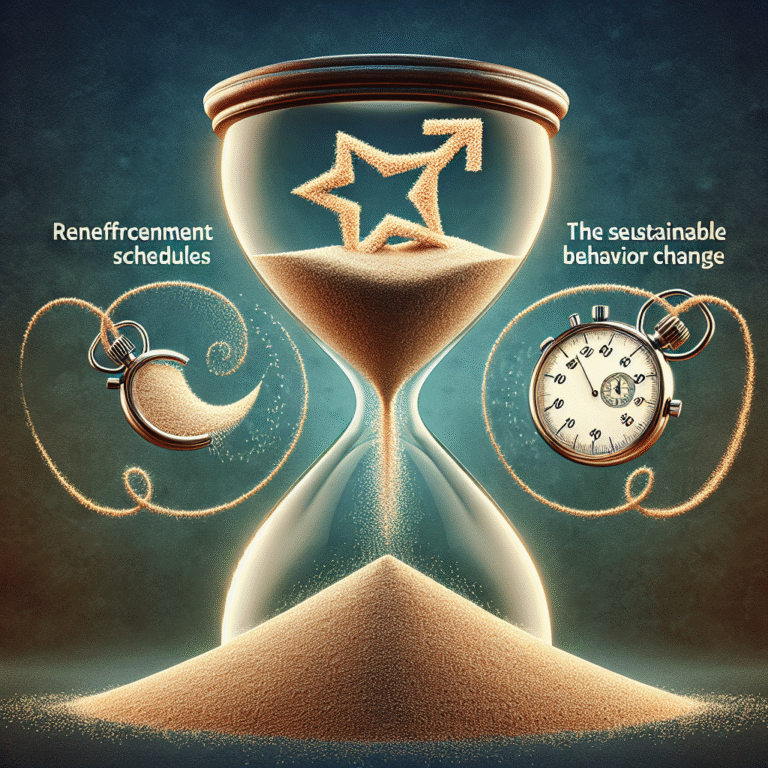
Introduction
In a world increasingly driven by instant gratification, the ability to transform one’s habits is more relevant than ever. Whether you’re aiming to lead a healthier lifestyle, improve productivity at work, or cultivate better relationships, knowing The Power of Reinforcement: Transforming Habits Through Operant Conditioning can serve as your secret weapon. This powerful principle from behavioral psychology has the ability to reshape your daily routines, making lasting changes not just possible, but practical. Through the strategic use of rewards and punishments, operant conditioning paves the way for new, sustainable habits that can enhance your overall well-being.
Understanding Operant Conditioning
What is Operant Conditioning?
Operant conditioning is a learning process through which the strength of a behavior is modified by reinforcement or punishment. Proposed by B.F. Skinner, this theory suggests that behaviors followed by positive outcomes are likely to repeat, while those followed by negative consequences are less likely to occur.
Key Components
Reinforcement: A consequence that increases the likelihood of a behavior occurring again. It can be:
- Positive Reinforcement: Adding a positive stimulus (e.g., rewards).
- Negative Reinforcement: Removing a negative stimulus (e.g., alleviating discomfort).
Punishment: A consequence that decreases the likelihood of a behavior recurring. This can also take two forms:
- Positive Punishment: Adding a negative consequence (e.g., scolding).
- Negative Punishment: Removing a positive stimulus (e.g., taking away privileges).
- Extinction: The reduction of a behavior when reinforcement is no longer provided.
Why Operant Conditioning Matters
Understanding operant conditioning is essential for effective habit transformation. By harnessing The Power of Reinforcement: Transforming Habits Through Operant Conditioning, you gain tools to make impactful changes in various aspects of your life.
The Science Behind Habit Formation
The Habit Loop
Habits are formed through a loop consisting of three elements: cue, routine, and reward.
- Cue: A trigger that encourages the brain to go into automatic mode and prompts the behavior.
- Routine: The behavior itself, which can be good or bad.
- Reward: The benefit resulting from the behavior, reinforcing its occurrence in the future.
The Role of Dopamine
Dopamine plays a critical role in reinforcing behaviors. This neurotransmitter is released during reward-seeking behaviors, signaling to the brain that a particular action is worth repeating.
Strategies for Implementing Operant Conditioning
1. Identify Your Target Habits
Before you start, it’s crucial to identify which habits you want to change. This requires self-assessment and reflection.
2. Utilize Positive Reinforcement
Create a reward system for yourself. For instance, if your goal is to work out more, reward yourself with a treat, a favorite TV show, or a relaxing bath after each session.
Case Study: Employee Productivity
In a corporate environment, an organization implemented a reward system where employees received gift cards for meeting monthly targets. This strategy not only boosted morale but also significantly enhanced overall productivity. The connection here exemplifies The Power of Reinforcement: Transforming Habits Through Operant Conditioning in a workplace setting.
| Month | Target Met (%) | Employee Satisfaction (Scale 1-10) |
|---|---|---|
| January | 75% | 7 |
| February | 85% | 8 |
| March | 95% | 9 |
3. Implement Negative Reinforcement
Negative reinforcement doesn’t mean punishment—rather, it involves removing undesirable outcomes. For example, if you dread waking up early to exercise, consider eliminating late-night distractions.
Case Study: Quitting Smoking
In a study involving smokers, those who set aside money saved from not buying cigarettes reported feeling relieved and maintained their resolve through the removal of the stress associated with smoking. This scenario shows The Power of Reinforcement: Transforming Habits Through Operant Conditioning in action by alleviating discomfort and promoting healthier choices.
4. Track Your Progress
Monitoring your habits fosters accountability. Utilize apps or journals to record your progress and identify areas for improvement.
The Importance of Consistency
Establishing consistency in applying reinforcement strategies is key. According to research, behaviors reinforced frequently are more likely to become habitual. Keep reminding yourself of the significance of The Power of Reinforcement: Transforming Habits Through Operant Conditioning as you persist through the ups and downs of change.
Common Challenges and Solutions
1. Lack of Immediate Results
Solution: Focus on small, incremental changes and understand that transformation takes time.
2. External Distractions
Solution: Design your environment to minimize distractions. For example, put your phone in another room when working.
3. Underestimating the Cue
Solution: Identify and eliminate cues that trigger negative habits. Keep a schedule that prompts positive behaviors.
4. Losing Motivation
Solution: Regularly remind yourself of your goals and the benefits of the changes you wish to make.
Conclusion
The journey of transforming habits is not an easy road, but the insights provided by The Power of Reinforcement: Transforming Habits Through Operant Conditioning can lighten your path. By understanding the mechanisms behind operant conditioning, you equip yourself with the tools necessary for lasting change. Remember, it’s the small victories that pave the way for significant transformations.
Take Action!
Start applying the principles discussed today in your daily life. Remember, change begins with the first step, be it rewarding yourself for small achievements or systematically replacing negative habits.
FAQs
1. What is operant conditioning?
Operant conditioning is a behavioral learning process that modifies behavior through reinforcement and punishment.
2. How can I apply operant conditioning to my life?
Begin by identifying target habits, implementing reinforcement strategies, and tracking your progress consistently.
3. Is negative reinforcement the same as punishment?
No, negative reinforcement involves removing unpleasant elements to encourage a behavior, while punishment aims to decrease a behavior.
4. How long does it take to establish a new habit?
Research suggests it can take anywhere from 21 to 66 days or more to create lasting habits, depending on the individual and the habit’s complexity.
5. Can operant conditioning work for emotional habits?
Yes, operant conditioning can help in managing emotional habits by rewarding positive emotions and reducing negative triggers.
Apply these insights and start harnessing The Power of Reinforcement: Transforming Habits Through Operant Conditioning for a better, more productive you!














